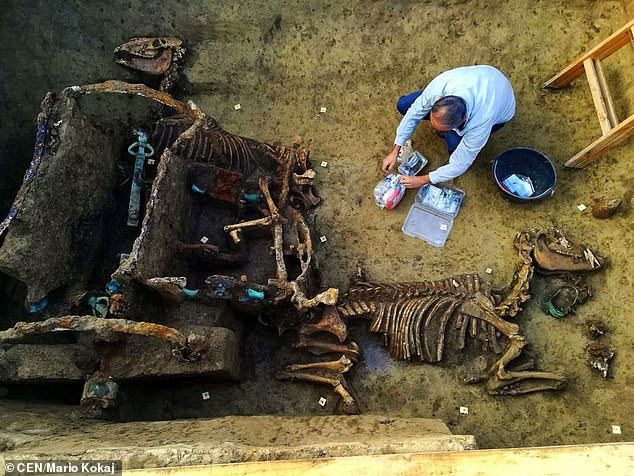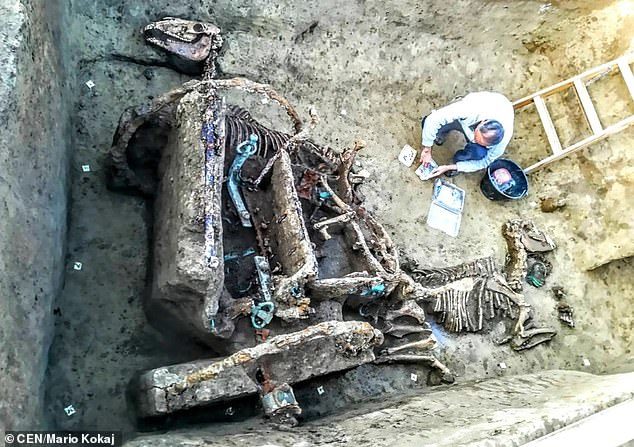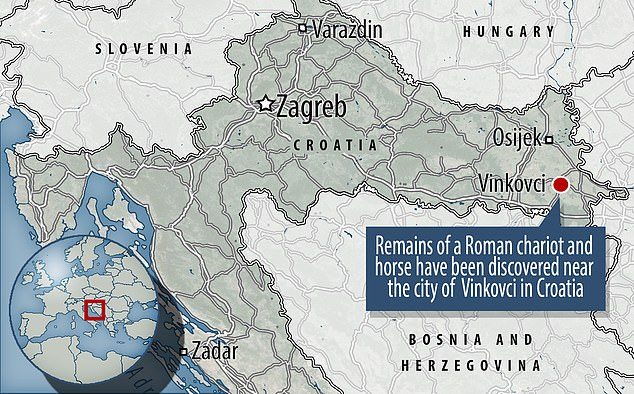
A large burial chamber for an 'extremely wealthy family' was found in which the carriage with what appears to be two horses had been lain.
Archaeologists from the City Museum Vinkovci and Institute of Archaeology from Zagreb discovered the Roman carriage on two wheels (known in Latin as a cisium) with horses at the Jankovacka Dubrava site close to the village of Stari Jankovci, near the city of Vinkovci, in eastern Croatia.
The horses' remains and the chariot were all buried together in what appears to have been a ritual reserved for very wealthy families
The discovery is believed to be an example of how those with extreme wealth were sometimes buried along with their horses.
Curator Boris Kratofil explained to local media that the custom of burial under tumuli (an ancient burial mound) was an exceptional burial ritual during the Roman period in the south of the Pannoinan Basin.
He said: 'The custom is associated with extremely wealthy families who have played a prominent role in the administrative, social and economic life of the province of Pannonia.'
The discovery is estimated to be from the third century AD but the team of scientists are working to confirm its age.
The discovery of Roman carriage with horses. The incredible discovery of a Roman chariot complete with the fossilised remains of horses

The director of the Institute of Archaeology Marko Dizdar said that it was a sensational discovery which is unique in Croatia.
He said: 'After this comes a long process of restoration and conservation of the findings, but also a complete analysis of the findings.
'In a few years we will know a little more about the family whose members were buried in this area 1,800 years ago.
'We are more interested in the horses themselves, that is, whether they were bred here or came from other parts of the empire, which will tell us more about the importance and wealth of this family.
'We will achieve this through cooperation with domestic as well as numerous European institutions.'
Archaeologists say the discovery will allow them to know a little more about the family whose members were buried in this area 1,800 years ago
THE ROMAN EMPIRE IN CROATIA:
Early inhabitants of Croatia were the Illyrians, an Indo-European people, who moved into the region in approximately 1000 BC.
The Celts invaded in the 4th century BC pushing the Illyrians towards what is now Albania.
In 168BC the Romans conquered the last Illyrian king, Genthius, and took over the region.
They slowly grew the Roman province of Illyricum through wars, taking over most of the Dalmatian coast, renaming Illyricum as Dalmatia (covering most of today's Croatia), and extending their empire to cover much of the area below the Danube river by 11BC.
Romans ruled Dalmatia for five hundred years, building roads linking the Aegean and Black sea with the Danube river for trade purposes and using Solin as their capital.
Other towns of importance to the Romans within 'Croatia' were Jadera (Zadar), Parentium (Poreč), Polensium (Pula) and Spalato (Split).
As the Roman Empire began to crumble in the late 3rd century AD the region was divided into two; Dalmatia Salonitana and Dalmatia Praevalitana (with its capital now part of modern Albania).
This laid the path for the division of the Eastern and Western Roman Empires.
In 395 AD the empire was divided into Eastern and Western Empires with modern day Slovenia, Croatia and Bosnia and Hercegovina in the West and Serbia, Kosovo and Macedonia on the East - later becoming the Byzantine Empire.




Comment: See also:
- Plague and climate change devastated fading Byzantine empire
- 536 AD: Plague, famine, drought, cold, and a mysterious fog that lasted 18 months
- The destruction of ancient Rome - The barbarians were not responsible
- Did the Romans build earthquake "invisibility cloaks" into structures?
Also check out SOTT radio's: